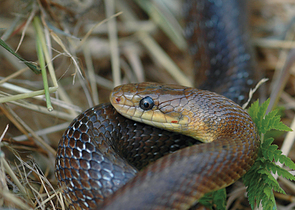Nature Conservation 1/2010 — 16. 2. 2010 — Nature and Landscape Management — Print article in pdf
Action Plan for the Aesculapian Snake in the Czech Republic

The Aesculapian Snake (Zamenis longissimus) occurs in three mutually separated populations in the Czech Republic: Podyjí/Thaya River Basin, Bílé Karpaty/White Carpathians Mts. and Poohří/Ohře River basin.
The first two populations are a part of the species’ continuous European distribution range, while population in Poohří/Ohře River Basin is isolated and represents the northernmost site of occurrence of the snake species. The Aesculapian Snake requires warm, moderately moist climate and a landscape with high heterogeneity. The reptile is often quite dependent on human activities. It is classified as Critically Endangered in the Czech Republic and is also protected by the European Communitys legislation. Due to registered decline of this snake in many countries and due to the occurrence of the small isolated population in Poohří/Ohře River Basin, a nationwide Action Plan for the Aesculapian Snake was prepared and was approved by the Ministry of the Environment of the Czech Republic in October 2008. Its main goal is to keep viable wild populations of Aesculapian Snake in all the three areas of occurrence; more specific goals are set for each area based on what we have already known about the individual populations. The most important measures within the Action Plan are following: establishing and managing new artificial egg laying sites, management of important habitat elements (dry stone walls, composts, piles of wood, sawdust heaps, rocks, balks, etc.), protection of individuals during migration across roads and while cutting grass in ditches, research in the species reproduction and ecology, education and – of course – proper monitoring. Since the approval of the Action Plan, many of these measures have been implemented in all the three areas, with the greatest amount of work being done in Poohří/Ohře River Basin. So far, the Action Plan seems to be going well. Effectiveness of its proposed measures can already be seen due to observation of snakes at egg laying sites very shortly after they are built, or in improved habitats. Moreover, the implemented measures are also beneficial to other reptile, invertebrate and plant species. The Action Plan is expected to ensure the implementation of necessary and regular measures to support the Aesculapian Snake populations in the Czech Republic in upcoming years.

